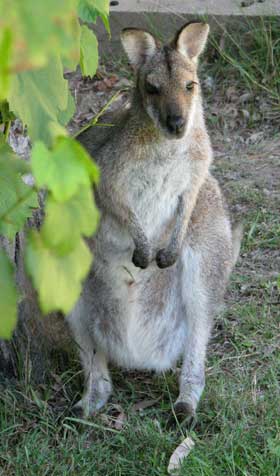 This young wallaby mother has taken to sleeping up against the western wall of the cabin. As the eaves are wide, it is usually dry and warm there, with heat reflected from the mud walls and the rock base further along.
This young wallaby mother has taken to sleeping up against the western wall of the cabin. As the eaves are wide, it is usually dry and warm there, with heat reflected from the mud walls and the rock base further along.
She is quite relaxed about me walking up and down the nearby steps. The other day her joey poked its pink and only thinly furred face almost out of the pouch — just to see who was talking to its mother.
A brief hello and it popped back in. I am going to enjoy watching this one grow up.
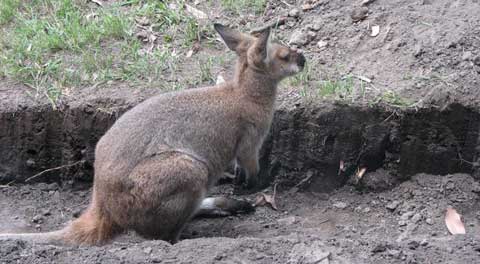 Other wallabies, like this male, choose the warm dirt and cosy sides of the excavation trench for the bathroom. The latter hasn’t progressed at all, as I am too busy, but if it makes a playground or cubby or daybed for the wallabies, that’s a plus anyway.
Other wallabies, like this male, choose the warm dirt and cosy sides of the excavation trench for the bathroom. The latter hasn’t progressed at all, as I am too busy, but if it makes a playground or cubby or daybed for the wallabies, that’s a plus anyway.
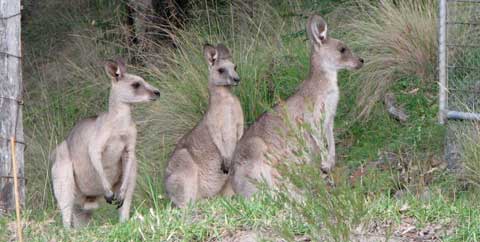 Although it is wallaby world here, the regular kangaroos are gradually getting used to me. This trio of adolescent kangaroo boys is new, and properly wary of coming into the open yard. They stood and sniffed and looked and turned their ears every which way before entering.
Although it is wallaby world here, the regular kangaroos are gradually getting used to me. This trio of adolescent kangaroo boys is new, and properly wary of coming into the open yard. They stood and sniffed and looked and turned their ears every which way before entering.

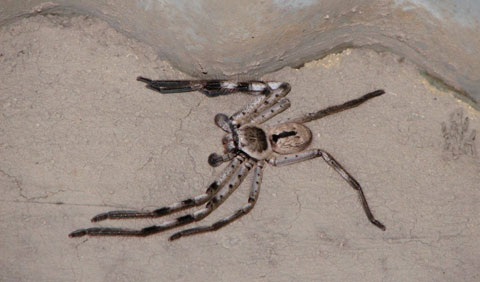
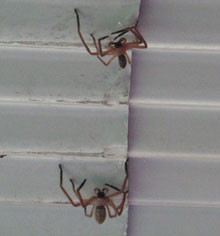
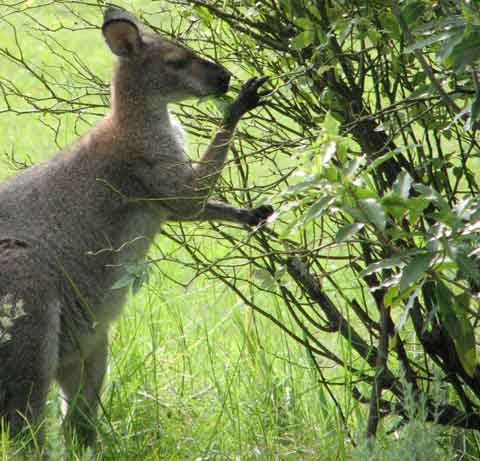 It hasn’t taken long for the wallabies to make themselves at home in the house yard. The roses are the main feeding attraction, with them stripping all the smaller bushes, and making considerable effort to reach up and pull down the stems of higher ones, like the old shrub rose, Autumnalis, and the Banksia Rose.
It hasn’t taken long for the wallabies to make themselves at home in the house yard. The roses are the main feeding attraction, with them stripping all the smaller bushes, and making considerable effort to reach up and pull down the stems of higher ones, like the old shrub rose, Autumnalis, and the Banksia Rose. The other quickly-acquired daily habit is occupying shady spots– one each, probably claimed and kept. The shade may be quite small, from a single shrub, or from man-made objects like the barbeque.
The other quickly-acquired daily habit is occupying shady spots– one each, probably claimed and kept. The shade may be quite small, from a single shrub, or from man-made objects like the barbeque. I do like seeing them so relaxed when I am about, and I am learning to unclench my teeth and be more relaxed myself when I see them eating the roses — or the Robinia — or the Buddleia — or the grapevines. A new era, I keep telling myself, and I chose it. So get used to it and enjoy!
I do like seeing them so relaxed when I am about, and I am learning to unclench my teeth and be more relaxed myself when I see them eating the roses — or the Robinia — or the Buddleia — or the grapevines. A new era, I keep telling myself, and I chose it. So get used to it and enjoy!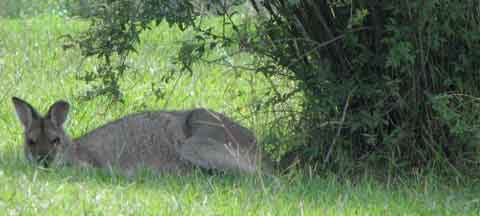
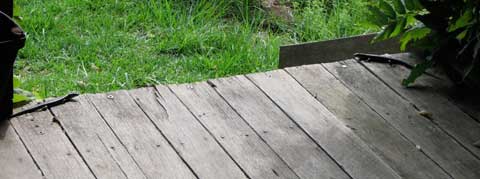 During the recent wet spell and see-sawing temperatures, my resident skinks must have had trouble finding warm dry spots. I have what I think is a mother and child as the smaller one is getting bigger and less nervous of my approach.
During the recent wet spell and see-sawing temperatures, my resident skinks must have had trouble finding warm dry spots. I have what I think is a mother and child as the smaller one is getting bigger and less nervous of my approach.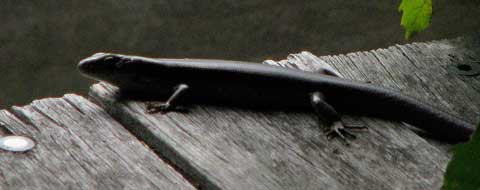 But they were fine, only guarding the entrance, immobile and at attention, like any good sentinel. And no doubt too cool to run fast!
But they were fine, only guarding the entrance, immobile and at attention, like any good sentinel. And no doubt too cool to run fast!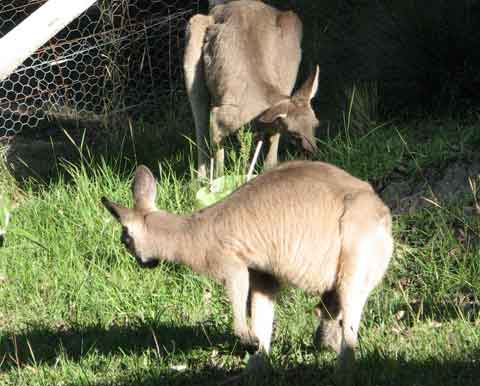 One late afternoon I opened all four gates into the house yard. You will not have your wallaby photos obscured by netting from now on.
One late afternoon I opened all four gates into the house yard. You will not have your wallaby photos obscured by netting from now on.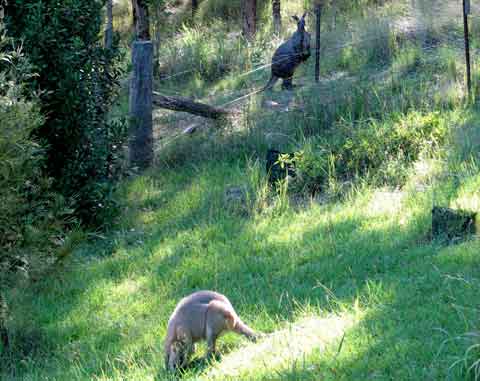 Slowly they ventured in. Wallabies first. The wallaroo looked on disapprovingly from outside the fence, where he stayed. Kangaroos are coming in too, but not close yet.
Slowly they ventured in. Wallabies first. The wallaroo looked on disapprovingly from outside the fence, where he stayed. Kangaroos are coming in too, but not close yet. Soon they were everywhere, and over the next few days some began to rest inside the yard, using the shade of buildings and trees during the day. Some were more calm than others, some staying still as I walked past, others bolting in panic.
Soon they were everywhere, and over the next few days some began to rest inside the yard, using the shade of buildings and trees during the day. Some were more calm than others, some staying still as I walked past, others bolting in panic.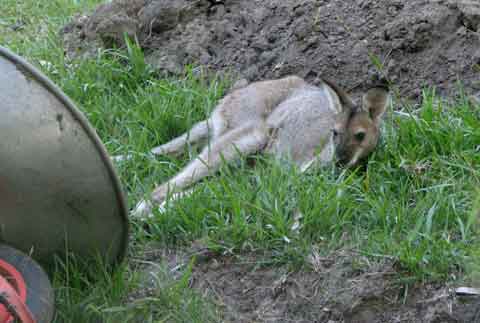 I immediately cleaned some strategic windows so I could take photos, like this laid-back wallaby. I enjoy observing the process of familiarisation. This is a new era of living here for me — and my neighbours.
I immediately cleaned some strategic windows so I could take photos, like this laid-back wallaby. I enjoy observing the process of familiarisation. This is a new era of living here for me — and my neighbours.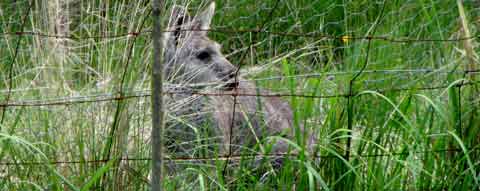 The longhairs of the macropods around here are the Wallaroos. I have always had one small family or a couple here, and they prefer the rocky edges, usually only coming close to drink at the dam. But lately the couple have been grazing near the fence line.
The longhairs of the macropods around here are the Wallaroos. I have always had one small family or a couple here, and they prefer the rocky edges, usually only coming close to drink at the dam. But lately the couple have been grazing near the fence line. Her male partner is the real standout — bigger and beefier, with long dark shaggy ‘hair’. He also has the doglike face, and perhaps the very long fur helps this impression. Much more wary than his wife, he stopped mid-munch at the sight of me.
Her male partner is the real standout — bigger and beefier, with long dark shaggy ‘hair’. He also has the doglike face, and perhaps the very long fur helps this impression. Much more wary than his wife, he stopped mid-munch at the sight of me. Drawing himself erect to show his broad chest and powerful shoulders, he soon took off into the treeline to hide from me. I don’t know if he had told her to follow or sent a warning, but she stayed put and kept eating. Was she smarter or just stubborn?
Drawing himself erect to show his broad chest and powerful shoulders, he soon took off into the treeline to hide from me. I don’t know if he had told her to follow or sent a warning, but she stayed put and kept eating. Was she smarter or just stubborn?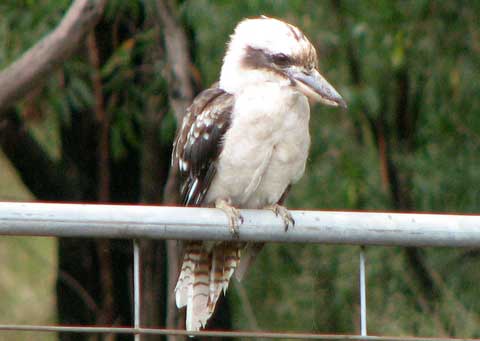 This photo of a vigilant kookaburra on my yard gate suits this extract from the chapter on Kookaburras in my book, Mountain Tails:
This photo of a vigilant kookaburra on my yard gate suits this extract from the chapter on Kookaburras in my book, Mountain Tails: On a recent damp day, as the wallabies grazed past the house fence, one female seemed to have a light stripe across the nose.
On a recent damp day, as the wallabies grazed past the house fence, one female seemed to have a light stripe across the nose. After watching for a while as she fed and bent up and down and scratched and twisted about, I fetched the camera to zoom closer and try to determine if it was a scar or no.
After watching for a while as she fed and bent up and down and scratched and twisted about, I fetched the camera to zoom closer and try to determine if it was a scar or no.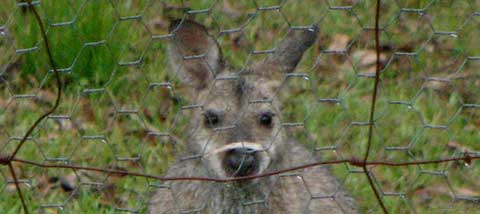 Closer still, it was revealed as a dead leaf — a damp dead leaf, pasted firmly across her nose by the rain.
Closer still, it was revealed as a dead leaf — a damp dead leaf, pasted firmly across her nose by the rain. About a metre away was the black snake, minding its own business and poking about near the earth I had just dumped. Damn! I could not continue work with it so close.
About a metre away was the black snake, minding its own business and poking about near the earth I had just dumped. Damn! I could not continue work with it so close.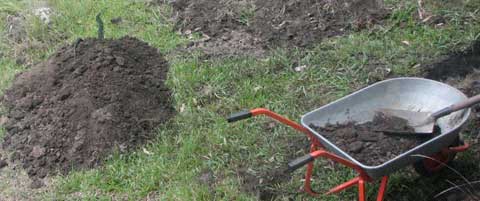 I ceded the territory and went around the house to the verandah to watch where it went. Having satisfied its curiosity, the snake continued up the slope to the gate.
I ceded the territory and went around the house to the verandah to watch where it went. Having satisfied its curiosity, the snake continued up the slope to the gate.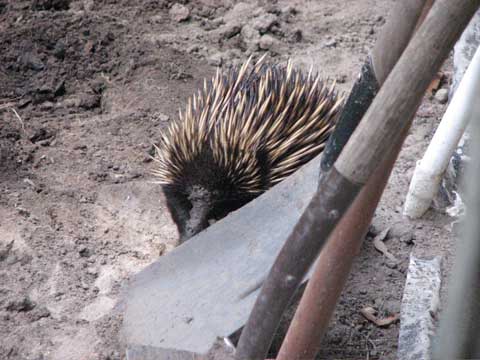 For that day I had also seen the echidna following the track, now barely distinguishable to me — but clearly not so to them. Like the snake, it detoured to investigate what my digging was turning up.
For that day I had also seen the echidna following the track, now barely distinguishable to me — but clearly not so to them. Like the snake, it detoured to investigate what my digging was turning up.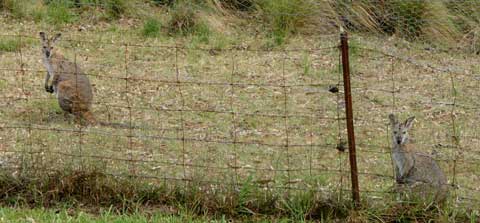 The dainty Red-necked Wallabies are my most common marsupial here, and I daily see small groups grazing along the yard fence line, not far from my verandah. When I appear, they usually look up to see what I’m doing, then it’s heads back down to resume eating.
The dainty Red-necked Wallabies are my most common marsupial here, and I daily see small groups grazing along the yard fence line, not far from my verandah. When I appear, they usually look up to see what I’m doing, then it’s heads back down to resume eating.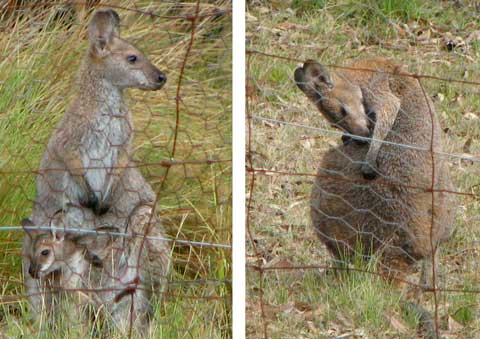 Often the Red-necked Wallaby mothers that I see here seem far too small to be mothers. By the time the joey is old enough to stay out of the pouch it is nearly as big as its mum. This one (left) wasn’t venturing out today but it was leaning out and doing a bit of practice grazing.
Often the Red-necked Wallaby mothers that I see here seem far too small to be mothers. By the time the joey is old enough to stay out of the pouch it is nearly as big as its mum. This one (left) wasn’t venturing out today but it was leaning out and doing a bit of practice grazing.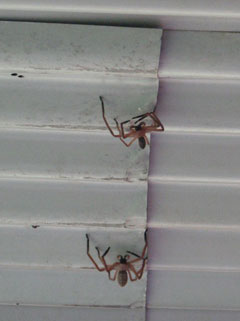 One afternoon in this recent wild hot November that broke records and threatened many places with fire, I ventured out of my dim cabin to see what the sky was doing. It was dim because I was trying to keep the heat out with the curtains drawn; in any case the winds were too strong to risk an open casement window snapping and straining on its stay peg.
One afternoon in this recent wild hot November that broke records and threatened many places with fire, I ventured out of my dim cabin to see what the sky was doing. It was dim because I was trying to keep the heat out with the curtains drawn; in any case the winds were too strong to risk an open casement window snapping and straining on its stay peg.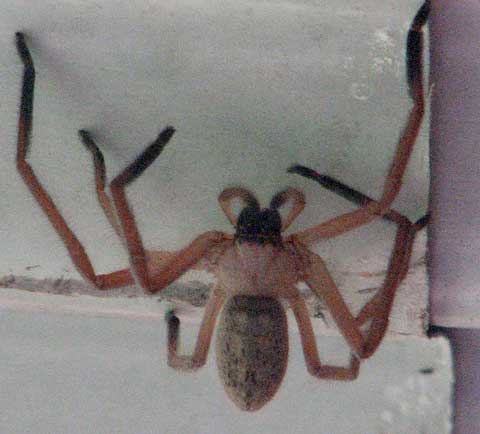 I walked to the other end of the verandah, on the lookout for other creatures seeking cooler relief. Seeing none, I turned to take some more photos of my hot-footed pair. They were gone!
I walked to the other end of the verandah, on the lookout for other creatures seeking cooler relief. Seeing none, I turned to take some more photos of my hot-footed pair. They were gone!